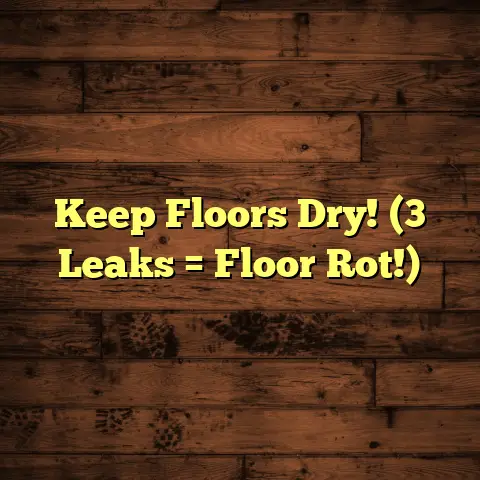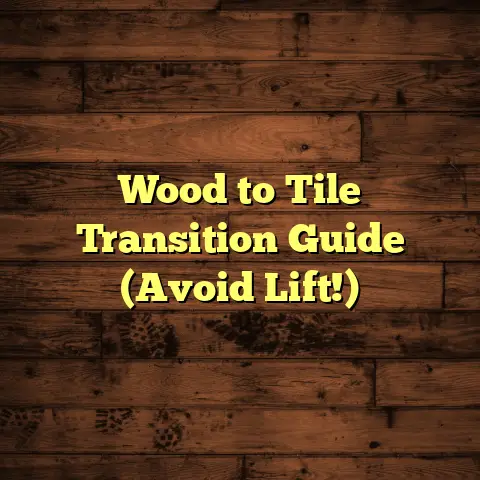Fix Uneven Old Floors? (1 Day Leveling Secret!)
Flooring. It’s something we walk on every day, often without a second thought. But did you know that the pursuit of level and durable floors dates back to ancient times? Think about the Romans. They understood the importance of a solid foundation, literally. Their amphitheaters and public spaces weren’t just grand; they were built to last, starting from the ground up.
Uneven floors aren’t a new problem. Throughout history, they’ve been a challenge, affecting not just how our homes look but also how they function. And let’s be honest, nobody wants to live in a house that feels like a funhouse mirror! I’ve seen firsthand how frustrating it can be.
Section 1: Understanding Uneven Floors
So, what exactly makes a floor “uneven”? Well, it’s any surface that isn’t perfectly horizontal. This can manifest in dips, humps, or slopes across the floor.
What causes this? Here are a few common culprits:
- Settling Foundations: Over time, the ground beneath your house can shift, causing the foundation to settle unevenly. This is probably the biggest culprit I encounter.
- Moisture Issues: Water damage can warp wood and other flooring materials, leading to unevenness. Think leaky pipes or poor drainage.
- Natural Wear and Tear: Let’s face it, floors take a beating. Years of foot traffic and heavy furniture can cause some areas to sag or wear down more than others.
- Poor Initial Installation: Sometimes, the problem starts right from the beginning. If the subfloor wasn’t properly leveled during the initial construction, the flooring on top will reflect those imperfections.
What’s the big deal about uneven floors?
- Safety Hazards: Tripping hazards are a real concern, especially for young children and older adults.
- Furniture Placement Woes: Ever try to put a table on an uneven floor? It wobbles, things roll off, it’s a nightmare.
- Aesthetic Appeal: An uneven floor just looks bad. It can make your entire home feel dated and poorly maintained.
Think back to those Roman structures. They weren’t just trying to build something pretty. A level floor was crucial for stability and functionality. Imagine trying to stage a gladiator fight on a sloping surface!
Section 2: Signs of Uneven Floors
How do you know if you have an uneven floor? Here are some telltale signs I’ve picked up over the years:
- Visible Gaps: Check for gaps between floorboards or tiles. These gaps often indicate that the floor has shifted or settled unevenly.
- Creaking Sounds: Creaks and squeaks are often a sign that the subfloor is rubbing against the flooring due to unevenness.
- Sloping Surfaces: This is the most obvious sign. Use a level or even a marble to see if the floor slopes in a particular direction.
- Doors That Stick: Uneven floors can throw door frames out of alignment, causing doors to stick or be difficult to close.
Don’t have a fancy level? No problem! Here’s a quick and dirty trick I use all the time:
- Grab a marble or a small ball.
- Place it on the floor in different areas.
- If the marble rolls consistently in one direction, you’ve got a slope.
Ignoring uneven floors can lead to bigger problems down the road. It can stress the foundation of your home, cause further damage to the flooring, and even affect the resale value of your property.
Section 3: The Importance of Leveling Floors
Why bother leveling your floors? Let’s break it down:
- Enhanced Safety: Level floors eliminate tripping hazards, making your home safer for everyone.
- Improved Aesthetics: A level floor looks clean, polished, and well-maintained. It instantly elevates the look of your home.
- Increased Property Value: Buyers are always looking for homes that are in good condition. Level floors are a sign of a well-cared-for property.
Beyond the practical benefits, there’s also a psychological aspect to consider. A well-maintained home environment can reduce stress and improve your overall sense of well-being. Uneven floors, on the other hand, can create a sense of unease or discomfort.
Think about it. We crave stability in our lives. A level floor provides that sense of stability, both literally and figuratively.
Flooring has evolved over centuries to meet our needs for safety, stability, and comfort. From the simple earthen floors of ancient dwellings to the intricate tile work of Renaissance palaces, the desire for a solid, level surface has always been a fundamental human need.
Section 4: Preparing for the Leveling Process
Okay, you’ve decided to tackle those uneven floors. Great! But before you jump in, you need to prepare. Here’s what you’ll need:
Tools and Materials:
- Self-Leveling Compound: This is the star of the show. Choose a high-quality compound that’s designed for your specific type of flooring.
- Mixing Bucket: A large bucket for mixing the self-leveling compound.
- Drill with Mixing Paddle: This will make mixing the compound much easier.
- Spiked Roller: Used to remove air bubbles from the self-leveling compound.
- Level: A good level is essential for checking your progress.
- Straight Edge: A long, straight piece of wood or metal to help you screed the compound.
- Shop Vac: For cleaning up dust and debris.
- Painter’s Tape: To protect walls and trim.
- Plastic Sheeting: To cover furniture and other items.
- Gloves and Safety Glasses: Safety first!
Preparing the Space:
- Clear the Room: Remove all furniture, rugs, and other items from the room.
- Clean the Floor: Thoroughly clean the floor with a shop vac to remove dust, dirt, and debris.
- Address Underlying Issues: If you have any moisture problems, address them before you start leveling. This might involve repairing leaks or improving ventilation.
- Protect the Walls and Trim: Use painter’s tape to protect the walls and trim around the perimeter of the room.
- Prime the Floor: Apply a primer to the floor to help the self-leveling compound adhere properly.
Thorough preparation is key to a successful leveling outcome. Don’t skip any steps!
Section 5: The 1-Day Leveling Secret
Alright, let’s get to the good stuff! The “1-Day Leveling Secret” relies on the power of self-leveling compounds. These amazing products allow you to achieve professional-looking results without the need for extensive renovations.
Here’s how it works:
- Mix the Compound: Carefully follow the manufacturer’s instructions for mixing the self-leveling compound. Use a drill with a mixing paddle to ensure that the compound is thoroughly mixed and free of lumps.
- Pour the Compound: Pour the mixed compound onto the floor, starting in the deepest areas.
- Spread the Compound: Use a straight edge to spread the compound evenly across the floor.
- Remove Air Bubbles: Use a spiked roller to remove any air bubbles from the compound. This will help to ensure a smooth, even surface.
- Let it Cure: Allow the compound to cure according to the manufacturer’s instructions. This typically takes 24-48 hours.
Time Estimates:
- Preparation: 2-4 hours
- Mixing and Pouring: 1-2 hours
- Curing: 24-48 hours
Tips for Success:
- Temperature Considerations: The ideal temperature for applying self-leveling compound is between 60°F and 80°F (15°C and 27°C).
- Curing Times: Curing times can vary depending on the temperature and humidity. Be sure to follow the manufacturer’s instructions.
- Don’t Rush: Take your time and work carefully. Rushing the process can lead to uneven results.
Choosing the Right Compound
Not all self-leveling compounds are created equal. Here’s what to consider:
- Floor Type: Different compounds are designed for different types of flooring. Make sure you choose one that’s compatible with your existing floor.
- Thickness: Consider the depth of the unevenness. Some compounds are designed for small imperfections, while others can handle larger dips and humps.
- Drying Time: Some compounds dry faster than others. If you’re on a tight schedule, choose a quick-drying compound.
Cost Breakdown
While costs can vary based on location and product choice, here’s a rough idea:
- Self-Leveling Compound: \$30-\$50 per bag (covers roughly 50 sq ft at 1/4″ thickness)
- Primer: \$20-\$40 per gallon
- Tools (mixing bucket, paddle, spiked roller): \$50-\$100 (if you don’t already own them)
A Word of Caution
While self-leveling compounds are relatively easy to use, they’re not a magic bullet. If you have major structural issues, such as a severely damaged foundation, you’ll need to address those problems before you can level the floor.
Section 6: Post-Leveling Care and Maintenance
You’ve leveled your floors! Congratulations! But the job isn’t quite done yet. Here’s how to care for your newly leveled floors to prevent future unevenness:
- Regular Inspections: Regularly inspect your floors for any signs of new unevenness.
- Moisture Barriers: If you live in a humid climate, consider installing a moisture barrier to protect your floors from water damage.
- Foundation Adjustments: If your uneven floors are caused by foundation settling, you may need to make adjustments to the foundation.
- Choose the Right Finish: Select a flooring finish that’s durable and easy to maintain.
Flooring Types That Work Best
Some flooring types are more forgiving than others when it comes to leveling. Here are a few good options:
- Tile: Tile is a great choice for leveled floors because it’s durable and resistant to moisture.
- Laminate: Laminate flooring is another good option because it’s relatively inexpensive and easy to install.
- Engineered Wood: Engineered wood flooring is a good compromise between solid wood and laminate. It looks like real wood but is more resistant to moisture.
Section 7: Real-Life Success Stories
I’ve helped countless homeowners transform their uneven floors using the 1-Day Leveling Secret. Here are a few of my favorite success stories:
The Case of the Creaky Kitchen:
- The Problem: A homeowner in an older home had a kitchen floor that was noticeably sloped and creaky.
- The Solution: We used a self-leveling compound to level the floor and then installed new tile.
- The Result: The kitchen floor is now level, quiet, and beautiful. The homeowner was thrilled with the results.
The Saga of the Sagging Living Room:
- The Problem: A homeowner had a living room floor that was sagging in the middle.
- The Solution: We used a self-leveling compound to fill in the sag and then installed new laminate flooring.
- The Result: The living room floor is now level and stable. The homeowner was amazed at how much of a difference it made.
The Challenge of the Uneven Bathroom:
- The Problem: A homeowner had a bathroom floor that was uneven due to water damage.
- The Solution: We repaired the water damage, used a self-leveling compound to level the floor, and then installed new tile.
- The Result: The bathroom floor is now level, waterproof, and beautiful. The homeowner was relieved to finally have a functional bathroom.
Challenges and Solutions
No project is without its challenges. Here are some common hurdles and how to overcome them:
- Air Bubbles: As mentioned earlier, air bubbles can be a problem with self-leveling compounds. Use a spiked roller to remove them.
- Uneven Drying: If the compound dries too quickly, it can crack. Make sure the room is properly ventilated and avoid applying the compound in direct sunlight.
- Settling: In rare cases, the compound may settle slightly after it dries. If this happens, you may need to apply a second coat.
Conclusion
Uneven floors are a common problem, but they don’t have to be a permanent one. With the 1-Day Leveling Secret, you can transform your uneven floors into smooth, level surfaces that enhance the safety, beauty, and value of your home.
Remember those Romans we talked about at the beginning? They valued level surfaces for a reason. It’s not just about aesthetics; it’s about creating a space that’s comfortable, functional, and safe. Just like our ancestors, we can reclaim our space and comfort through effective flooring solutions.
So, what are you waiting for? Grab your tools, gather your materials, and get ready to level up your home!





